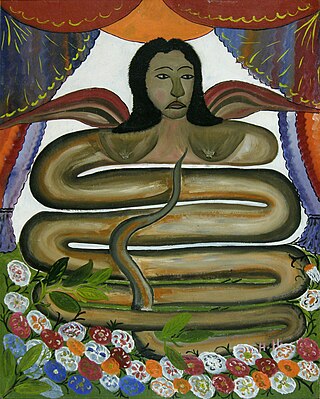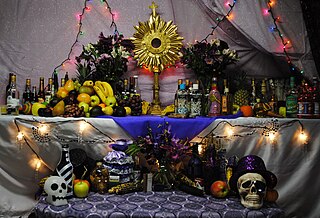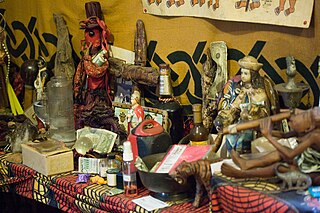Related Research Articles

Lwa, also called loa, are spirits in the African diasporic religion of Haitian Vodou. They have also been incorporated into some revivalist forms of Louisiana Voodoo. Many of the lwa derive their identities in part from deities venerated in the traditional religions of West Africa, especially those of the Fon and Yoruba.

Ifá is a divination system originating among the Yoruba people of West Africa. It plays an important role in Yoruba religion and certain African diasporic religions deriving from it, such as Cuban Santería.
Haitian mythology consists of many folklore stories from different time periods, involving sacred dance and deities, all the way to Vodou. Haitian Vodou is a syncretic mixture of Roman Catholic rituals developed during the French colonial period, based on traditional African beliefs, with roots in Dahomey, Kongo and Yoruba traditions, and folkloric influence from the indigenous Taino peoples of Haiti. The lwa, or spirits with whom Vodou adherents work and practice, are not gods but servants of the Supreme Creator Bondye. A lot of the Iwa identities come from deities formed in the West African traditional regions, especially the Fon and Yoruba. In keeping with the French-Catholic influence of the faith, Vodou practioneers are for the most part monotheists, believing that the lwa are great and powerful forces in the world with whom humans interact and vice versa, resulting in a symbiotic relationship intended to bring both humans and the lwa back to Bondye. "Vodou is a religious practice, a faith that points toward an intimate knowledge of God, and offers its practitioners a means to come into communion with the Divine, through an ever evolving paradigm of dance, song and prayers."
Palo, also known as Las Reglas de Congo, is an African diasporic religion that developed in Cuba during the late 19th or early 20th century. It arose through a process of syncretism between the traditional Kongo religion of Central Africa, the Roman Catholic branch of Christianity, and Spiritism. Initiates in the religion are termed paleros (male) or paleras (female).

Homosexuality in Haitian Vodou is religiously acceptable and homosexuals are allowed to participate in all religious activities. However, in West African countries with major conservative Christian and Islamic views on LGBTQ people, the attitudes towards them may be less tolerant if not openly hostile and these influences are reflected in African diaspora religions following Atlantic slave trade which includes Haitian Vodou.
Tambor is a coastal Afro-Venezuelan music and dance. It is a cultural manifestation originating in the slaves from Africa. The drums are of Kongo origin, as are most musical genres of Afro-Venezuelan origin. The Tambores are done with the playing of a cumaco which is a long cylinder-shaped drum played on the ground while the player sits on it and plays. It also consists of drums known as campanas which are played by sitting down in a chair and playing them with the hands. These drums are often used for religious ceremonies. In the Afro-Catholic community, it is used to honour and invoke San Juan or some other Saint. In the Maria Lionza context, the drums are used to invoke the spirits to possess the materia or medium as well as to animate the spirit and give it force.
The Arará people form an Afro-Cuban ethnoreligious group descended from the Dahomey kingdom of West Africa, and retaining an identity, religion, and culture separate from those of other Afro-Cuban peoples. Although, historically, the Arará people have been staunch defenders of their separate heritage and religion, this distinct identity - while it still persists - has, over time, become increasingly blurred and harder to maintain.

Haitian Vodou is an African diasporic religion that developed in Haiti between the 16th and 19th centuries. It arose through a process of syncretism between several traditional religions of West and Central Africa and Roman Catholicism. There is no central authority in control of the religion and much diversity exists among practitioners, who are known as Vodouists, Vodouisants, or Serviteurs.

Christianity is the most widely professed religion in the Dominican Republic. Historically, Catholicism dominated the religious practices of the country, and as the official religion of the state it receives financial support from the government. About 60% of Dominicans identify themselves as Catholic.

Louisiana Voodoo, also known as New Orleans Voodoo, is an African diasporic religion that originated in Louisiana. It arose through a process of syncretism between the traditional religions of West Africa, the Roman Catholic form of Christianity, and Haitian Vodou. No central authority is in control of Louisiana Voodoo, which is organized through autonomous groups.
Vodou drumming and associated ceremonies are folk ritual faith system of henotheistic religion of Haitian Vodou originated and inextricable part of Haitian culture.
Various LGBT themes are present in different in African diasporic mythologies, primary among them being Voodoo.

Santería, also known as Regla de Ocha, Regla Lucumí, or Lucumí, is an African diasporic religion that developed in Cuba during the late 19th century. It arose through a process of syncretism between the traditional Yoruba religion of West Africa, the Roman Catholic form of Christianity, and Spiritism. There is no central authority in control of Santería and much diversity exists among practitioners, who are known as creyentes ("believers").
Lucumí is a lexicon of words and short phrases derived from the Yoruba language and used for ritual purposes in Cuba and the Cuban Diaspora. It is used as the liturgical language of Santería in Cuba and other communities that practice Santería/Cuban Orisa/the Lucumí religion/Regla de Ocha.

Haitian Vodou art is art related to the Haitian Vodou religion. This religion has its roots in West African traditional religions brought to Haiti by slaves, but has assimilated elements from Europe and the Americas and continues to evolve. The most distinctive Vodou art form is the drapo Vodou, an embroidered flag often decorated with sequins or beads, but the term covers a wide range of visual art forms including paintings, embroidered clothing, clay or wooden figures, musical instruments and assemblages. Since the 1950s there has been growing demand for Vodou art by tourists and collectors.
In the Cuban religion of Santería, omiero, also known as purificacíon de santo, is a liquid used in various ritual acts.
In the Caribbean religion of Santería, individuals are required to go through an initiation process to become a full practitioner, known as a santero (male) or santera (female).
Santería is an Afro-Cuban religion that arose in the 19th century.
Bondye, also known Gran Maître, is the supreme creator god in the African diasporic religion of Haitian Vodou. Vodouists believe Bondye was responsible for creating the universe and everything in it, and that he maintains the universal order. They nevertheless deem him to be transcendent and thus inaccessible to humans, who must instead interact with spirits called lwas.
Voodoo in popular culture encompasses various representations of practices associated with different forms of voodoo, including Haitian Vodou and Louisiana Voodoo, and other elements attributed to African diaspora religions, with such representations often deviating substantially from any actual voodoo practices or beliefs. Tropes regarding voodoo appear most often in supernatural fantasy or horror films, with common themes including the activity of witch doctors, the summoning or control of dark spirits, use of voodoo dolls to inflict pain on people remotely, and the creation of zombies.
References
Citations
- 1 2 Dodson 2008, p. 104.
- ↑ Cosentino 1995, p. 29.
- ↑ Bellegarde-Smith & Michel 2006, p. xix.
- ↑ Cosentino 1995, p. 26; Derby 2015, p. 396.
- ↑ Derby 2015, p. 397.
- ↑ Castañeda 2007, p. 137; Wirtz 2007, p. 29.
- ↑ Fernández Olmos & Paravisini-Gebert 2011, pp. 89, 95.
- ↑ Hagedorn 2001, pp. 22–23; Mason 2002, p. 88.
- ↑ Hagedorn 2001, pp. 22–23, 105.
- 1 2 3 Dodson 2008, p. 105.
- ↑ Dodson 2008, pp. 106–107.
- 1 2 Dodson 2008, p. 107.
- ↑ Dodson 2008, p. 109.
- ↑ Dodson 2008, pp. 109–110.
- ↑ Dodson 2008, p. 110.
- ↑ McAlister 2002, pp. 100–104.
- 1 2 3 Dodson 2008, p. 112.
- 1 2 Dodson 2008, p. 113.
- 1 2 Dodson 2008, p. 114.
- ↑ Dodson 2008, pp. 113–114.
- ↑ Dodson 2008, pp. 117–118.
- ↑ Dodson 2008, p. 121.
- ↑ Dodson 2008, p. 122.
- ↑ Hagedorn 2001, p. 133.
Sources
- Bellegarde-Smith, Patrick; Michel, Claudine (2006). "Introduction". In Bellegarde-Smith, Patrick; Michel, Claudine (eds.). Haitian Vodou: Spirit, Myth and Reality. Bloomington and Indianapolis: Indiana University Press. pp. xvii–xxvii. ISBN 978-0253218537.
- Castañeda, Angela N. (2007). "The African Diaspora in Mexico: Santería, Tourism, and Representations of the State". In Theodore Louis Trost (ed.). The African Diaspora and the Study of Religion. New York: Palgrave Macmillan. pp. 131–50. doi:10.1057/9780230609938_8. ISBN 978-1403977861.
- Cosentino, Donald J. (1995). "Imagine Heaven". In Donald J., Cosentino (ed.). Sacred Arts of Haitian Vodou. Los Angeles: UCLA Fowler Museum of Cultural History. pp. 25–55. ISBN 0-930741-47-1.
- Derby, Lauren (2015). "Imperial Idols: French and United States Revenants in Haitian Vodou". History of Religions. 54 (4): 394–422. doi:10.1086/680175. JSTOR 10.1086/680175. S2CID 163428569.
- Dodson, Jualynne E. (2008). Sacred Spaces and Religious Traditions in Oriente Cuba. Alburquerque: University of New Mexico Press. ISBN 978-0826343536.
- Fernández Olmos, Margarite; Paravisini-Gebert, Lizabeth (2011). Creole Religions of the Caribbean: An Introduction from Vodou and Santería to Obeah and Espiritismo (second ed.). New York and London: New York University Press. ISBN 978-0-8147-6228-8.
- Hagedorn, Katherine J. (2001). Divine Utterances: The Performance of Afro-Cuban Santería. Washington, DC: Smithsonian Books. ISBN 978-1560989479.
- Mason, Michael Atwood (2002). Living Santería: Rituals and Experiences in an Afro-Cuban Religion. Washington, DC: Smithsonian Books. ISBN 978-1588340528.
- McAlister, Elizabeth (2002). Rara! Vodou, Power, and Performance in Haiti and its Diaspora. Berkeley: University of California Press. ISBN 978-0520228221.
- Viddal, Grete (2012). "Vodú Chic: Haitian Religion and the Folkloric Imaginary in Socialist Cuba". NWIG: New West Indian Guide / Nieuwe West-Indische Gids. 86 (3/4): 205–235. doi: 10.1163/13822373-90002414 . JSTOR 24713388. S2CID 145157609.
- Wirtz, Kristina (2007). Ritual, Discourse, and Community in Cuban Santería: Speaking a Sacred World. Gainesville: University Press of Florida. ISBN 978-0813030647.